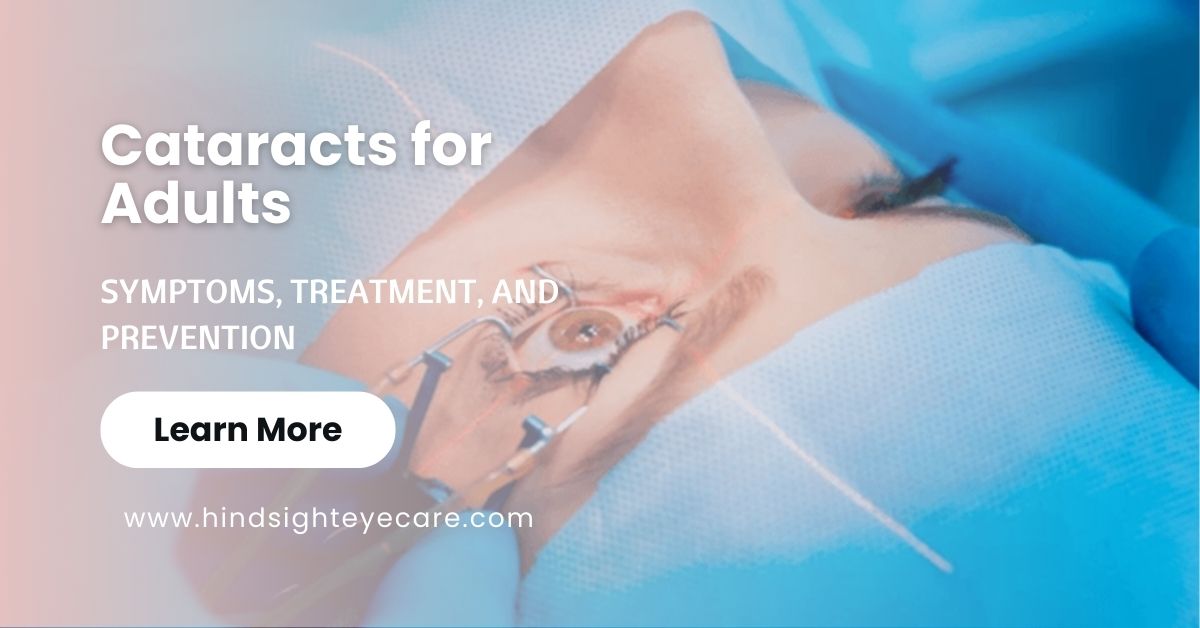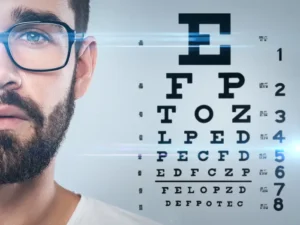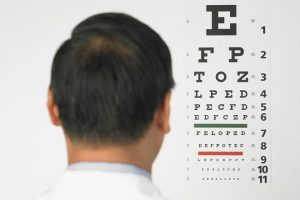Cataracts for Adults
Cataracts are a natural part of aging, affecting millions of Americans, particularly those over 60. But what exactly are they? Dr. James Russell, our lead optometrist at Hindsight Eye Care, explains:
“Imagine looking through a foggy window – that’s similar to how cataracts affect your vision. Cataracts occur when the natural lens in your eye becomes cloudy, making it difficult for light to pass through clearly.”
This cloudiness can develop slowly over time, often without noticeable symptoms in the early stages. That’s why regular eye exams are crucial, especially as we age.
For many of our patients in The Villages, cataracts can significantly impact daily life. Activities like reading, driving, or even recognizing faces can become challenging. But fear not – with proper care and treatment, you can continue enjoying life’s beautiful moments with clarity.
Cataract Symptoms: What to Watch For
Recognizing the signs of cataracts early can lead to better management and treatment outcomes. Here are some common symptoms to be aware of:
- Blurry or Cloudy Vision: If your vision seems less sharp, even with your current eyeglasses, it might be a sign of cataracts.
- Increased Sensitivity to Light: Bright lights or glare might seem more bothersome than before.
- Difficulty Seeing at Night: Night driving may become more challenging due to halos around lights.
- Fading or Yellowing of Colors: Colors may appear less vibrant or take on a yellowish tinge.
- Frequent Changes in Eyeglass Prescription: If you find yourself needing new prescriptions more often, cataracts could be the cause.
- Double Vision in One Eye : This can occur as the cataract progresses.
- The Need for Brighter Light for Reading: You might find yourself turning up the lamp brightness more often.
Dr. James Russell adds, “Many of our patients at Hindsight Eye Care initially dismiss these symptoms as just ‘getting older.’ But recognizing them early allows us to monitor and manage cataracts more effectively.”
Types of Cataracts
Not all cataracts are the same. Understanding the different types can help you better comprehend your eye health:
- Nuclear Cataracts: These form in the center of the lens and can temporarily improve near vision before worsening.
- Cortical Cataracts: Starting on the edges of the lens, these cataracts form spoke-like opacities extending inward.
- Posterior Subcapsular Cataracts: Forming at the back of the lens, these can progress faster and significantly affect reading vision.
- Congenital Cataracts: Some people are born with cataracts or develop them in childhood.
Risk Factors for Cataracts
While age is the primary risk factor for cataracts, other factors can increase your chances of developing them:
- Diabetes
- Smoking
- Excessive alcohol consumption
- Prolonged exposure to sunlight
- Certain medications (like corticosteroids)
- Previous eye injury or inflammation
- Family history of cataracts
How to diagnose Cataracts
At Hindsight Eye Care, we can’t stress enough the importance of regular eye exams, especially for our senior patients. During a comprehensive eye exam, we use various tests to check for cataracts and assess your overall eye health:
- Visual Acuity Test: This familiar eye chart test measures how well you can see at various distances.
- Slit-Lamp Examination: This allows us to examine your eye’s structures under magnification.
- Retinal Exam: We dilate your pupils to get a clear view of your retina and optic nerve.
- Tonometry: This measures your eye pressure to check for glaucoma, which can coexist with cataracts.
Dr. James Russell emphasizes, “Regular eye exams are your first line of defense against cataracts and other eye conditions. For most of our senior patients in The Villages, we recommend annual check-ups.”
Treatment Options For Cataracts: Clearing the Way to Better Vision
The good news is that cataracts are treatable. Depending on the severity and impact on your daily life, we offer several management and treatment options:
- Updated Eyeglass Prescription: In early stages, a new prescription for your eyeglasses or contact lenses might be sufficient to improve your vision.
- Lifestyle Modifications: Simple changes like using brighter lighting, wearing anti-glare sunglasses, or using magnifying lenses for reading can help manage mild cataracts.
- Cataract Surgery: When cataracts significantly affect your quality of life, surgery is a safe and effective option. This procedure involves removing the cloudy lens and replacing it with an artificial intraocular lens (IOL).
Table: Types of Intraocular Lenses (IOLs)
| Type of IOL | Description | Benefits |
| Monofocal | Provides clear vision at one distance (usually far) | Standard option, covered by insurance |
| Multifocal | Allows clear vision at multiple distances | Reduces dependence on glasses |
| Toric | Corrects astigmatism | Improves overall vision clarity |
| Accommodating | Changes shape within the eye, mimicking natural lens | Provides a range of vision similar to youthful eyes |
Dr. James Russell notes, “At Hindsight Eye Care, we work closely with top surgeons in The Villages to ensure our patients receive the best possible care for cataract surgery. We’ll guide you through the entire process, from pre-operative care to post-surgery follow-ups.”
How to Prevent Cataracts for Adults
While we can’t completely prevent age-related cataracts, there are steps you can take to reduce your risk and potentially slow their progression:
- Protect Your Eyes from UV Rays: Wear sunglasses and a wide-brimmed hat when outdoors. Look for sunglasses that block 100% of UVA and UVB rays.
- Quit Smoking: Smoking increases the risk of cataracts. If you need help quitting, we can provide resources and support.
- Eat a Healthy Diet: A diet rich in fruits and vegetables, particularly those high in antioxidants, may help prevent cataracts.
- Control Other Health Problems: Managing conditions like diabetes can slow cataract development.
- Limit Alcohol Consumption: Excessive alcohol intake has been linked to increased cataract risk.
- Regular Eye Exams: Early detection through regular check-ups can help manage cataracts more effectively.
A Personal Perspective on Cataracts
To give you a more personal insight, we spoke with Robert, a 72-year-old resident of The Villages and a long-time patient at Hindsight Eye Care. Diagnosed with cataracts five years ago, Robert initially opted for conservative management before eventually undergoing surgery.
Dr. James Russell’s experience highlights the life-changing impact that proper cataract management and treatment can have on seniors’ quality of life.
FAQs About Cataracts for Adults
To address some common concerns, here are answers to frequently asked questions we receive at Hindsight Eye Care:
Q: At what age do cataracts typically develop?
A: While cataracts can develop at any age, they’re most common in people over 60. By age 80, more than half of all Americans have cataracts or have had cataract surgery.
Q: Can cataracts come back after surgery?
A: No, cataracts cannot return after surgery because the natural lens where they form is removed. However, some people may experience clouding of the capsule that holds the artificial lens, which can be easily treated with a quick laser procedure.
Q: How long does cataract surgery take?
A: The surgery itself typically takes about 15-20 minutes per eye. However, you’ll need to plan for pre-op preparation and post-op recovery time.
Q: Will I still need glasses after cataract surgery?
A: This depends on the type of intraocular lens (IOL) you choose. Some patients may still need glasses for certain activities, while others achieve independence from glasses.
Q: Is cataract surgery painful?
A: Most patients report little to no discomfort during or after the procedure. Your eye will be numbed, and you’ll be given medication to help you relax.
Q: How long is the recovery period after cataract surgery?
A: Most people can resume normal activities within a few days, but complete healing may take several weeks. We’ll provide detailed post-operative care instructions.




